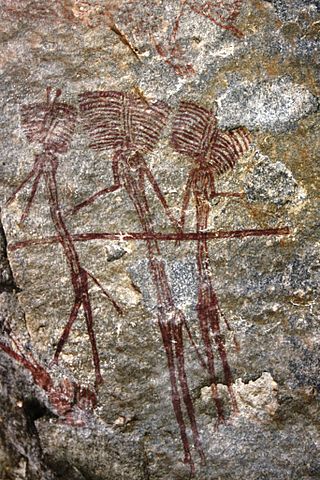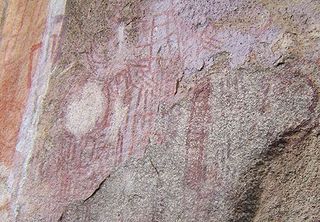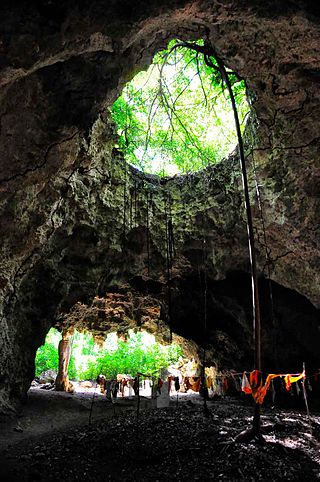
The Nok culture is a population whose material remains are named after the Ham village of Nok in southern Kaduna State of Nigeria, where their terracotta sculptures were first discovered in 1928. The Nok people and the Gajiganna people may have migrated from the Central Sahara, along with pearl millet and pottery, diverged prior to arriving in the northern region of Nigeria, and thus, settled in their respective locations in the region of Gajiganna and Nok. Nok people may have also migrated from the West African Sahel to the region of Nok. Nok culture may have emerged in 1500 BCE and continued to persist until 1 BCE.

The Kintampo complex, also known as the Kintampo culture, Kintampo Neolithic, and Kintampo Tradition, was established by Saharan agropastoralists, who may have been Niger-Congo or Nilo-Saharan speakers and were distinct from the earlier residing Punpun foragers, between 2500 BCE and 1400 BCE. The Kintampo complex was a part of a transitory period in the prehistory of West Africa, from pastoralism to sedentism in West Africa, specifically in the Bono East region of Ghana, eastern Ivory Coast, and Togo. The Kintampo complex also featured art, personal adornment items, polished stone beads, bracelets, and figurines; additionally, stone tools and structures were found, which suggests that Kintampo people had both a complex society and were skilled with Later Stone Age technologies.

The history of Nigeria before 1500 has been divided into its prehistory, Iron Age, and flourishing of its kingdoms and states. Acheulean tool-using archaic humans may have dwelled throughout West Africa since at least between 780,000 BP and 126,000 BP. Middle Stone Age West Africans likely dwelled continuously in West Africa between MIS 4 and MIS 2, and Iwo Eleru people persisted at Iwo Eleru as late as 13,000 BP. West African hunter-gatherers occupied western Central Africa earlier than 32,000 BP, dwelled throughout coastal West Africa by 12,000 BP, and migrated northward between 12,000 BP and 8000 BP as far as Mali, Burkina Faso, and Mauritania. The Dufuna canoe, a dugout canoe found in northern Nigeria has been dated to around 6556-6388 BCE and 6164-6005 BCE, making it the oldest known boat in Africa and the second oldest worldwide.

The Kondoa Rock-Art Sites or Kondoa Irangi Rock Paintings are a series of ancient paintings on rockshelter walls in central Tanzania. The Kondoa region was declared a UNESCO World Heritage Site in 2006 because of its impressive collection of rock art. These sites were named national monuments in 1937 by the Tanzania Antiquities Department. The paintings are located approximately nine kilometres east of the main highway (T5) from Dodoma to Babati, about 20 km north of Kondoa town, in Kondoa District of Dodoma Region, Tanzania. The boundaries of the site are marked by concrete posts. The site is a registered National Historic Sites of Tanzania.

Chongoni Rock Art Area is located in the Central Region of Malawi consisting of 127 sites in the forested hills of the Malawi plateau with depictions of rock art and paintings of the farmer community of the Late Stone Age and the Iron Age period. This ancient record of the cultural history is in vogue even now.
The Diy-Gid-Biy (DGB) sites are archaeological sites located around the Mandara Mountains of northern Cameroon and Nigeria, overlooking the several kilometers long Shikewe watershed. These sites get their name Diy-Gid-Biy from the Mafa language, which can be translated as "place of chiefly residence." There are 16 of these DGB sites which date back to around the 15th century AD. While knowledge of these sites has existed for some time, only in 2001 archaeologists began to investigate the sites and their cultural heritage in relation to the region.
Unguja Ukuu is a historic Swahili settlement on Unguja island, in Zanzibar, Tanzania.
Dhar Tichitt is a Neolithic archaeological site located in the southwestern region of the Sahara Desert in Mauritania. It is one of several settlement locations along the sandstone cliffs in the area. Tichitt culture includes Dhar Tichitt, Dhar Walata, Dhar Néma, and Dhar Tagant, and possibly sites from the Malian Lakes Region. Dhar Tichitt, which includes Dakhlet el Atrouss, may have served as the primary regional center for the multi-tiered hierarchical social structure of the Tichitt Tradition, and the Malian Lakes Region, which includes Tondidarou, may have served as a second regional center of the Tichitt Tradition. The cliffs of Dhar Tichitt were inhabited by farmers and pastoralists between 4500 BP and 2300 BP, or between 2500 BCE and 500 BCE.
Munsa is an archaeological site in Uganda, located in the south-eastern part of Bunyoro, and is commonly recognized by a rocky hill known by the locals as "Bikegete", which is enclosed within an earthworks system of ancient ditches. The site is approximately 5 kilometres (3.1 mi) north-west of Kakumiro township in Bugangaizi County, Kakumiro District. "Munsa" is a Runyoro(Lunyoro/Runyoro Edited by Nicholas Aliganyira Nkuuna) name that means "in the trenches". The architects of the earthworks are unknown, although it has been speculated that the site can be linked to the Bachwezi. There is no evidence for this, however, and it seems likely that association of Munsa with the Bachwezi or Chwezi is a recent development.
Boomplaas Cave is located in the Cango Valley in the foothills of the Swartberg mountain range, north of Oudtshoorn, Eden District Municipality in the Western Cape Province, South Africa. It has a 5 m (16 ft) deep stratified archaeological sequence of human presence, occupation and hunter-gatherer/herder acculturation that might date back as far as 80,000 years. The site's documentation contributed to the reconstruction of palaeo-environments in the context of changes in climate within periods of the Late Pleistocene and the Holocene. The cave has served multiple functions during its occupation, such as a kraal (enclosure) for animals, a place for the storage of oil rich fruits and as a hunting camp. Circular stone hearths and calcified dung remains of domesticated sheep as well as stone adzes and pottery art were excavated indicating that humans lived at the site and kept animals.
Sirikwa holes are saucer-shaped hollows found on hillsides in the western highlands of Kenya and in the elevated stretch of the central Rift Valley around Nakuru. These hollows, each having a diameter of 10–20 metres and an average depth of 2.4 metres, occur in groups, sometimes numbering fewer than ten and at times more than a hundred. Archaeologists believe that construction of these features may have begun in the Iron Age.
The Bahi Rock-Art Sites or Bahi rock paintings are rock art located at three sites in the Dodoma region of Tanzania. These white paintings are believed to be products of the Wamia people, who occupied the region before the Wagogo people. The paintings, which depict cattle, human figures, stools, gourds, a bird, and an arrow, among other symbols, were supposedly executed during important occasions such as funerals. The Wagogo people, though not fully aware of the original significance of the paintings to the Wamia, have continued to use the sites as sacred locations for rain-making ceremonies. The Bahi paintings are estimated to be at least 340 years old based on the genealogy of the Bahi chief in 1929, which revealed the estimated time of his ancestor Kimanchambogo's arrival in the area. The white painting method is generally associated with Bantu-speaking farming populations.
Indo-Pacific beads are a type of mainly tube drawn glass beads which originated in the Indian subcontinent but manufactured widely in Southeast Asia. These are usually 6mm in diameter, undecorated and come in various colours for example green, yellow, black, opaque red, etc.
Nasera Rockshelter is an archaeological site located in the Ngorongoro Conservation Area within Ngorongoro District of Arusha Region in northern Tanzania, and it has evidence of Middle Stone Age and Later Stone Age occupations in the Late Pleistocene to early Holocene, and ceramic-bearing Holocene occupations attributed to Kansyore, Nderit, and Savanna Pastoral Neolithic traditions. It was first excavated by Louis Leakey in 1932. A second series of excavations by Michael Mehlman in 1975 and 1976 led to the first comprehensive published study of the shelter, its stratigraphy and chronology, and its abundant material culture, including stone tools, faunal remains, and pottery. Recent work has sought to better understand chronology, lithic technology, mobility and demography, and site formation processes at Nasera Rockshelter. Nasera Rockshelter is considered a key site in eastern Africa for understanding the Middle Stone Age to Later Stone Age transition, and also for the study of the spread of livestock herding during the Pastoral Neolithic. Its chronology and archaeological sequence have been compared to those of other key sites in the region such as Mumba Rockshelter, Kisese II Rockshelter, Panga ya Saidi, and Enkapune ya Muto.

Kuumbi Cave is an archaeological site located in Kusini District, Unguja South Region of Tanzania. It has been important in determining patterns of human occupation since its formation over 20,000 years ago. Unusual lithic and ceramic finds dated within the last 2,000 years make Kuumbi Cave a unique site. Its name in Swahili, Pango la Kuumbi, translates to "Cave of Creation".

The Tichitt Culture, or Tichitt Tradition, was created by proto-Mande peoples. In 4000 BCE, the start of sophisticated social structure developed among herders amid the Pastoral Period of the Sahara. Saharan pastoral culture was intricate. By 1800 BCE, Saharan pastoral culture expanded throughout the Saharan and Sahelian regions. The initial stages of sophisticated social structure among Saharan herders served as the segue for the development of sophisticated hierarchies found in African settlements, such as Dhar Tichitt. After migrating from the Central Sahara, proto-Mande peoples established their civilization in the Tichitt region of the Western Sahara. The Tichitt Tradition of eastern Mauritania dates from 2200 BCE to 200 BCE.
Bosutswe is an archaeological site at the edge of the Kalahari Desert in Botswana on top of Bosutswe Hill. The site can be dated back to around 700 AD. The location of Bosutswe makes it easy for archaeologists to study as the record of the site is continuous. It is believed that the area was occupied consistently for around 1000 years. It was known for its advanced metalworking which first appeared around 1300 AD, which is known as the Lose Period. The Lose Period is named after the elite class that can be found in the area.

Bosumpra Cave is an archaeological site situated on the Kwahu plateau, which forms part of the easternmost section of the Ashanti uplands. The plateau and uplands lie just north of the Akan lowlands, and run diagonally across south-central Ghana for c. 200 km from near the western border with Ivory Coast to the edge of the Volta basin. The site is actually a rock shelter, which is roughly 240 m² in extent and situated at an elevation of approximately 613 m above sea-level, northeast of the modern town of Abetifi. In the shelter itself, the floor is lowest in the center and slopes upwards towards the northern and southern edges. The rock shelter is also situated in the Bono East region of Ghana, which is archaeologically important because of the large distribution of prehistoric Kintampo-sites here.
The Kisalian Graves are a series of burial sites located in the Northern part of the Upemba Depression, Democratic Republic of the Congo. They are a part of a larger collection of archaeological sites all dating back to the Iron Age of the region.
The Middle Niger is a region of Mali that includes Dia Shoma, Djenné-Djenno, Méma, Macina, and the Malian Lakes Region.








